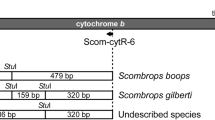Abstract
Planktonic crustaceans are traditionally identified based on morphological and morphometric characters. However, such characters may be hardly distinguishable and often overlap between species. A probability of misidentification is thus relatively high. Molecular techniques may increase the accuracy of identification if appropriate markers are used. Aim of our work was to develop a simple molecular procedure enabling discrimination between four species of Simocephalus occurring in Europe. PCR-RFLP technique proved to be suitable for such discrimination. Within the 709 bp fragment of mitochondrial cytochrome c oxidase subunit 1 gene we found unique combinations of restriction sites of the BbsI and SacI enzymes for Simocephalus vetulus, S. exspinosus, S. serrulatus and S. congener. PCR products of samples from several locations in Slovakia were digested with the two enzymes and electrophoresed on an agarose gel. The restriction patterns were clearly visible and easily distinguishable. This method is applicable for identifying the four species in any life-stage. Considering its simplicity and cost-effectiveness it can be widely used as a diagnostic tool for discriminating between Simocephalus species with overlapping morphologic characters.
Similar content being viewed by others
References
Ahmed A.O.A., Mukhtar M.M., Kools-Sijmons M., Fahal A.H., de Hoog S., van den Ende G.B., Zijlstra E.E., Verbrugh H., Abughroun E.S.A.M., Elhassan A.M. & van Belkum A. 1999. Development of a species-specific PCR-restriction fragment length polymorphism analysis procedure for identification of Madurella mycetomatis. J. Clin. Microbiol. 37: 3175–3178. PMID: 85521
Folmer O., Black M., Hoeh W., Lutz R. & Vrijenhoek R. 1994. DNA primers for amplification of mitochondrial cytochrome c oxidase subunit I from diverse metazoan invertebrates. Mol. Mar. Biol. Biotech. 3: 294–299. PMID: 7881515
Gajardo G., Crespo J., Triantafyllidis A., Tzika A., Baxevanis A.D., Kappas I. & Abatzopoulos T.J. 2004. Species identi-fication of Chilean Artemia populations based on mitochondrial DNA RFLP analysis. J. Biogeogr. 31: 547–555. DOI: 10.1111/j.1365-2699.2003.01046.x
Galan M., Pagès M. & Cosson J.-F. 2012. Next-generation sequencing for rodent barcoding: species identification from fresh, degraded and environmental samples. PLoS ONE 7(11): e48374. DOI: 10.1371/journal.pone.0048374
Hall T.A. 1999. BioEdit: a user-friendly biological sequence alignment editor and analysis program for Windows 95/98/NT. Nucleic Acids Symp. 41: 95–98.
Hann B.J. 1987. Naturally occurring interspecific hybridization in Simocephalus (Cladocera, Daphniidae): its potential significance. Hydrobiologia 145: 219–224. DOI: 10.1007/BF02530283
Hann B.J. 1995. Genetic variation in Simocephalus (Anomopoda: Daphniidae) in North America: patterns and consequences. Hydrobiologia 307: 9–14. DOI: 10.1007/BF00031992
Hebert P.D.N. 1985. Interspecific hybridization between cyclic parthenogens. Evolution 39: 216–220. DOI: 10.2307/2408534
Hebert P.D.N., Cywinska A., Ball S.L. & deWaard J.R. 2003a. Biological identifications through DNA barcodes. Proc. R. Soc. Lond. B 270: 313–322. DOI: 10.1098/rspb.2002.2218
Hebert P.D.N., Ratnasingham S. & deWaard J.R. 2003b. Barcoding animal life: cytochrome c oxidase subunit 1 divergences among closely related species. Proc. R. Soc. Lond. B 270(Suppl. 1): S96–S99. DOI: 10.1098/rsbl.2003.0025
Hudec I. 1993. Notes to the distribution of the genus Simocephalus (Crustacea: Daphniiformes, Daphniidae) in Slovakia. Biologia 48: 141–147.
Hudec I. 1995. Variability of Simocephalus vetulus (Crustacea: Anomopoda, Daphniidae) in Slovakia. Biologia 50: 465–473.
Ingaki Y., Ehara M., Watanabe K.I., Hayashi-Ishimaru Y. & Ohama, T. 1998. Directionally evolving genetic code: the UGA codon from stop to tryptophan in mitochondria. J. Mol. Evol. 47: 378–384. PMID: 9767683
Johns G.C. & Avise J.C. 1998. A comparative summary of genetic distances in the vertebrates from the mitochondrial cytochrome b gene. Mol. Biol. Evol. 15: 1481–1490. PMID: 12572611
Kalous L., ŠlechtovČech M. 2010. Do small fish mean no voucher? Using a flatbed desktop scanner to document larval and small specimens before destructive analyses. J. Appl. Ichthyol. 26: 614–617. DOI: 10.1111/j.1439-0426.2010.01471.x
Kohout J., Pekárik L., Šedivá A., Didenko A., Čiampor F. & Čiamporová-Zaťovičová Z. 2013. Discrimination between invasive Ponto-Caspian gobies using a PCR-RFLP method. J. Appl. Ichthyol., published online. DOI: 10.1111/jai.12315
Kress W.J., Wurdack K.J., Zimmer E.A., Weigt L.A. & Janzen D.H. 2005. Use of DNA barcodes to identify flowering plants. Proc. Natl. Acad. Sci. U.S.A. 102(23): 8369–8374. DOI: 10.1073/pnas.0503123102
Mirhendi H., Makimura K., Khoramizadeh M. & Yamaguchi H. 2006. A one-enzyme PCR-RFLP assay for identification of six medically important Candida species. Jpn. J. Med. Mycol. 47: 225–229. PMID: 16940958
Orlova-Bienkowskaja M.Y. 2001. Cladocera: Anomopoda: Daphniidae: genus Simocephalus. In: Dumont H.J.F. (ed.), Guides to the Identification of the Microinvertebrates of the Continental Waters of the World 17, SBA Acad. Publ. Hague, 130 pp. ISBN-10: 9057820900
Schwenk K. 1993. Interspecific hybridization in Daphnia: Distinction and origin of hybrid matrilines. Mol. Biol. Evol. 10: 1289–1302. PMID: 8277855
Širca S., Geric Stare B., Strajnar P. & Urek G. 2010. PCR-RFLP diagnostic method for identifying Globodera species in Slovenia. Phytopathol. Mediterr. 49: 361–369.
Šrámek-Hušek R. 1962. Cladocera — perloočky, pp. 174–410. In: Šrámek-Hušek R., Straškraba M. & Brtek J. (eds), Lupenonožci — Branchiopoda, Fauna ČSSR 16, NČSAV, Praha.
Traub R.J., Robertson I.D., Irwin P., Mencke N. & Thompson A. 2004. Application of a species-specific PCR-RFLP to identify Ancylostoma eggs directly from canine faeces. Vet. Parasitol. 123: 245–255. DOI: 10.1016/j.vetpar.2004.05.026
Young Sh-S., Ni M.-H. & Liu M.-Y. 2012. Systematic study of the Simocephalus sensu stricto species group (Cladocera: Daphniidae) from Taiwan by morphometric and molecular analyses. Zool. Stud. 51(2): 222–231.
Zapata M.A., Cienfuegos A.V., Quirós O.I., Quińones M.L., Luckhaart S. & Correa M.M. 2007. Discrimination of seven Anopheles species from San Pedro de Urabá, Antioquia, Colombia, by polymerase chain reaction-restriction fragment length polymorphism analysis of its sequences. Am. J. Trop. Med. Hyg. 77(1): 67–72. PMID: 17620632
Zaret T. 1969. Predation-balanced polymorphism of Ceriodaphnia cornuta Sars. Limnol. Oceanogr. 14: 301–303. DOI: 10.4319/lo.1969.14.2.0301
Author information
Authors and Affiliations
Corresponding author
Rights and permissions
About this article
Cite this article
Kohout, J., Illyová, M., Čiampor, F. et al. Discrimination between four Simocephalus species from Slovakia using a PCR-RFLP technique. Biologia 69, 76–79 (2014). https://doi.org/10.2478/s11756-013-0285-0
Received:
Accepted:
Published:
Issue Date:
DOI: https://doi.org/10.2478/s11756-013-0285-0




